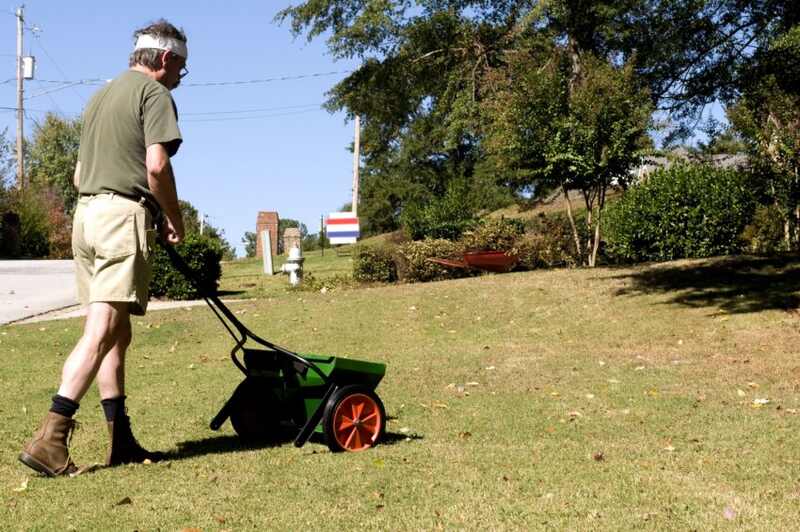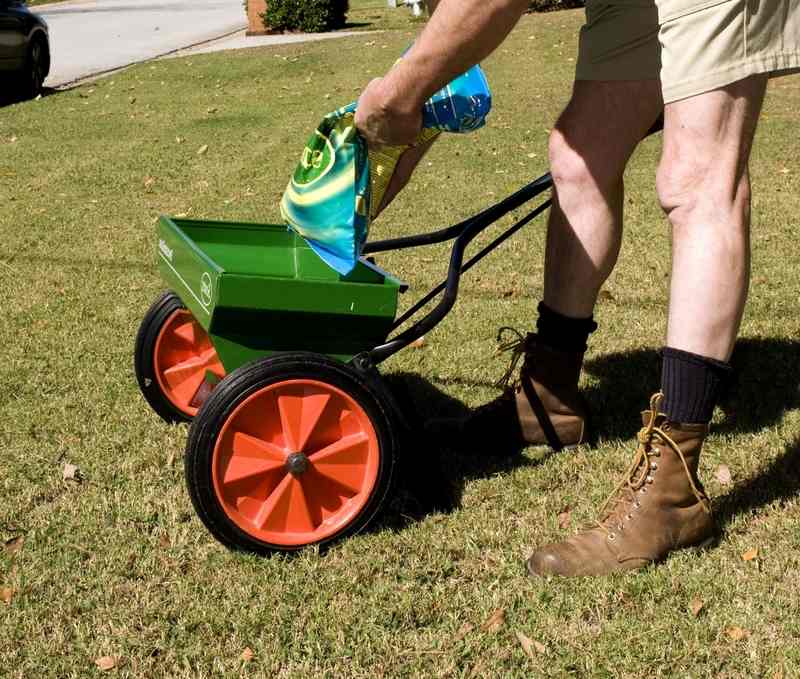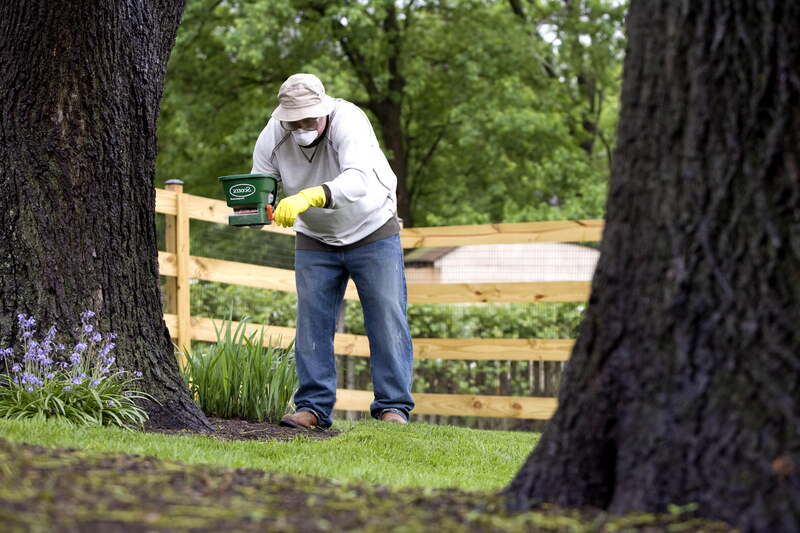What to Know About Fertilizing Your Lawn in Ohio
BY JUDITH GALLOVA | MAY 15TH, 2023 | LAWN CARE, OHIOA lush, green lawn takes work. But as they say, work smarter, not harder. One of the keys to achieving a beautiful lawn is knowing how and when to fertilize your lawn in Ohio.
Grass in the wild survives on nutrients from decomposing organic material. That’s fine, but sometimes it’s not enough. A lawn often requires some TLC to become and stay strong and consistently thick, and that means adding nutrients that your grass craves.
In this article:
- What Does Fertilizer Do?
- Do You Need to Fertilize? How Much?
- Organic Fertilizer as an Option
- Fertilizer Types
- The Best Times to Fertilize Your Lawn
- When to Use Starter Fertilizer
- When Not to Fertilize Your Lawn
- Before You Fertilize
- Final Thoughts
What Does Fertilizer Do?
You may wonder what fertilizer does for your lawn. In nature, grasses draw nutrients from decomposing organic matter. In a managed lawn, however, the grass may not receive enough of these nutrients. Malnourished grass may become thin, weak, and susceptible to pests and diseases.
If you build your lawn in healthy, rich soil and leave grass clippings on your lawn after mowing, that may be enough for a green and healthy lawn. But if your soil test shows nutrient deficiencies or imbalances, fertilizers can provide the necessary nutrients to help your grass grow healthy and green.
It’s important to use fertilizers properly and in moderation to avoid over-fertilization. You need to know what your soil is lacking, which fertilizer to use, and how much (be sure to always follow instructions).
Do You Need Fertilizer? How Much?

Photo Credit: Pixnio
Does your soil really need fertilizer, or will grass clippings suffice? Fertilizers mainly consist of three nutrients: nitrogen, phosphorus, and potassium. These nutrients are abbreviated as N-P-K. In different regions, grasses need various amounts of nutrients to grow best. Here’s what each of them does:
| Nutrient | Key Benefits |
| Nitrogen | • Helps rapid growth and protein synthesis • Increases leaf development for dense lawns |
| Phosphorus | • Helps early root growth • Promotes plant maturity and seed development |
| Potassium | • Increases drought and disease resistance |
Because of Ohio’s cool climate, you probably have a cool-season grass type such as:
- Kentucky bluegrass
- Tall fescue
- Fine fescue
- Perennial ryegrass
Ohio State University recommends a fertilizer ratio of 3:1:2 (nitrogen:phosphorous:potassium), 4:1:2, or 5:1:2 for lawns in the Buckeye State. Many organic fertilizers can’t precisely meet the recommended ratio. In that case, you should use the nitrogen value (the first number) as the deciding factor. You then need to calculate precisely how much of the product you should use for your lawn; using too much fertilizer is hazardous.
However, it’s useful to have your soil tested before selecting a fertilizer. Soil tests identify the specific nutrient needs of your lawn and determine whether you need to fertilize at all. The Department of Agriculture recommends testing your soil at least every two to three years, but if you want to make informed decisions about fertilizing your soil, you can do so even more often.
A soil test involves analyzing the composition of your soil to find out its:
- pH
- Organic matter percentage
- Nutrient levels (P, K, Mg, Ca)
- Micronutrient levels (S, Zn, Fe, Cu, Mn)
- Cation exchange capacity
You can either do a simple DIY test or send a soil sample to a local laboratory to get a detailed report. Once you’ve received the results of your soil test, you can take steps to address any issues and improve the health of your lawn. To know more about testing your soil in Ohio, you can check out this fact sheet from Ohio State University.
Organic Fertilizer as an Option
Chemical fertilizers aren’t the only option for improving soil health. Organic fertilizers are also effective, plus they’re environmentally friendly. So, if you want to reduce your carbon footprint and improve your soil, consider doing so organically.
Your first option is to use grass clippings. If you have soil rich in microbes and nutrients and regularly leave grass clippings on your lawn, you may not need to use fertilizer. You can use a mulching mower to chop your grass clippings into fine pieces that easily break down and feed your soil. This is the easiest and most environmentally friendly way to keep your grass healthy.
However, if that’s not enough for your soil, you can use a slow-release fertilizer made out of organic materials. That could be manure, alfalfa, compost, and so forth. There’s even the option of making your own fertilizer.
Note that organic fertilizers aren’t necessarily safer for pets. The materials that make up organic fertilizers may be dangerous to ingest (such as some plants, etc.). Moreover, store-bought organic fertilizers are often mixed with extremely toxic ingredients. Be careful, and don’t forget that animals tend to find the smell of organic ingredients more appealing.
No matter which fertilizer you use, you should always follow instructions. Don’t let any animals access your lawn for as long as advised or before the product settles (or dries, if it’s in liquid form), whichever happens last. Also, never use more fertilizer than needed. This is damaging to your lawn and dangerous to the environment and local animals.
Fertilizer Types

Photo Credit: Pixnio
There are various options for store-bought fertilizer. Most fertilizers are either dry or liquid, and they have their own pros and cons:
- Dry fertilizers: Dry fertilizers are usually granular and slow-release.
- Liquid fertilizers: Liquid fertilizers have to be diluted with water. Most of them are quick-release.
The difference between slow-release and quick-release fertilizers is as follows:
- Slow-release fertilizers are designed to release nutrients slowly over a longer period of time, providing a steady supply of nutrients to your lawn. They allow your grass to establish strong roots, are less likely to burn the grass, don’t force growth too quickly, and don’t leach as much into the ground and water.
- Quick-release fertilizers, on the other hand, release nutrients right away and provide a quick boost of growth to your lawn. However, they’re more likely to cause damage to your lawn if not applied correctly, and they often cause rapid grass growth. Moreover, they’re damaging to the environment because they’re significantly more likely to leach.
All things considered, slow-release fertilizers are usually the better option. They’re more suitable for feeding your grass, and they’re much less harmful to the environment.
The Best Times to Fertilize Your Lawn
How often should you fit fertilization into your schedule? If you have healthy, rich soil and want to use grass clippings, you can leave them on your lawn after each mow. However, be sure that your clippings aren’t too thick or stuck together so that your grass gets sufficient airflow.
If you need to use fertilizer, Ohio State University recommends doing so four times a year to provide your soil with sufficient nitrogen. That’s because nitrogen moves through soil over time. However, you can apply it only once in the spring if you applied fertilizer late in the fall of the previous year. If you only want to fertilize once a year, do so in the fall to store nutrients for the spring.
Here are the best months for fertilization in Ohio:
- First application: April; usually paired with a pre-emergent herbicide
- Second application: Late May; often be paired with broadleaf weed control
- Third application: Early September
- Last application: Generally, it’s beneficial to fertilize in late October to early December; if you’re based in northern, central, or southern Ohio, the recommended time is late November to early December
Note that fertilizing your lawn too often or with too much product can damage your lawn and harm the environment. Stick to the recommended guidelines and read your product instructions carefully.
When to Use Starter Fertilizer

Photo Credit: Pixnio
Are you establishing a new lawn? Don’t use regular fertilizer. Instead, if necessary, you can use a starter fertilizer specifically designed for new lawns. This will provide the necessary nutrients for seedlings and promote healthy root growth. It helps your grass seedlings and sod roods establish quicker than regular fertilizer, giving them a boost to thrive in their early stages.
Most starter fertilizers will contain equal amounts of nitrogen, phosphorus, and potassium, but some may contain two parts nitrogen and one part phosphorus and potassium. As with regular fertilizer, you can choose between different starter fertilizer types. Remember to always be careful when applying any fertilizer.
When Not to Fertilize Your Lawn
We’ve discussed the best times to fertilize your lawn, but when should you definitely not do so? There are a number of scenarios where fertilizing your lawn would be a bad idea. For example:
- If it’s the wrong season: In Ohio, the best time to fertilize is between April and December (see the section The Best Times to Fertilize Your Lawn above).
- If there’s a drought: Fertilizing during a drought can damage your lawn.
- If it’s been raining: Fertilizing wet grass may create runoff. The fertilizer is also less likely to be absorbed by the soil.
- If you expect your lawn to get busy: A freshly fertilized lawn should be left alone for as long as advised on the label or until the fertilizer has dried (or settled, if granular), whichever happens first.
- If your lawn doesn’t need it: As mentioned above, do a soil test to determine what nutrients your lawn is lacking.
Before You Fertilize
Fertilizers are hazardous substances, and it’s important to follow guidelines and stay safe at all times. Here are a few heads-ups to keep in mind before you fertilize your lawn:
- Calculate how much you need: Over-fertilizing poses a danger to you, your pets, local wildlife, and the environment
- Read and follow the instructions on the fertilizer label carefully: Not following instructions can likewise have detrimental effects
- Protect yourself: Wear gloves and protective clothing when handling fertilizer to protect your skin from irritation and other potential health hazards.
- Prevent water contamination: Avoid applying fertilizer near water sources.
- Keep your animals away from fertilizer: Animals should be off your lawn for as long as advised on your product label or until it dries (if liquid) or settles (if solid)
Final Thoughts
Making sure that you have healthy soil rich in nutrients is necessary for your grass to grow strong and healthy. However, it’s equally critical to follow other maintenance practices, such as mowing, watering, and overseeding, to see the best results.
Need a hand maintaining your lawn? Be sure to get in touch with one of WikiLawn’s Ohio lawn care pros.